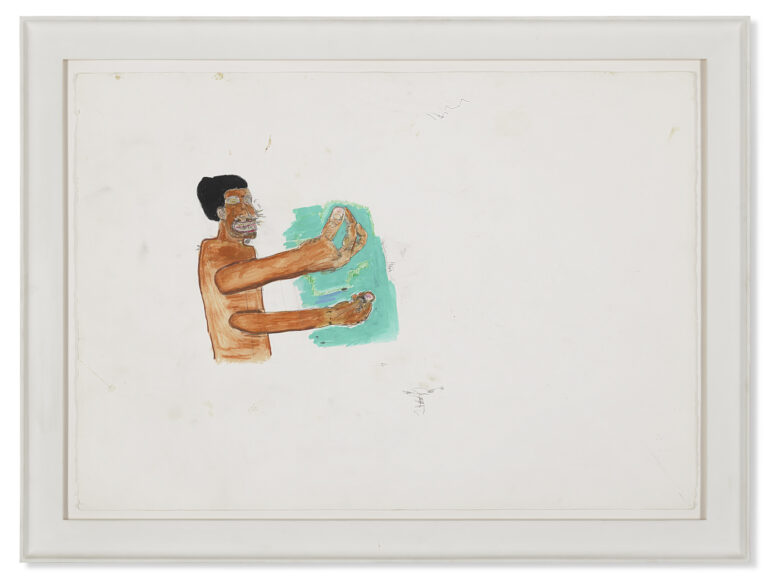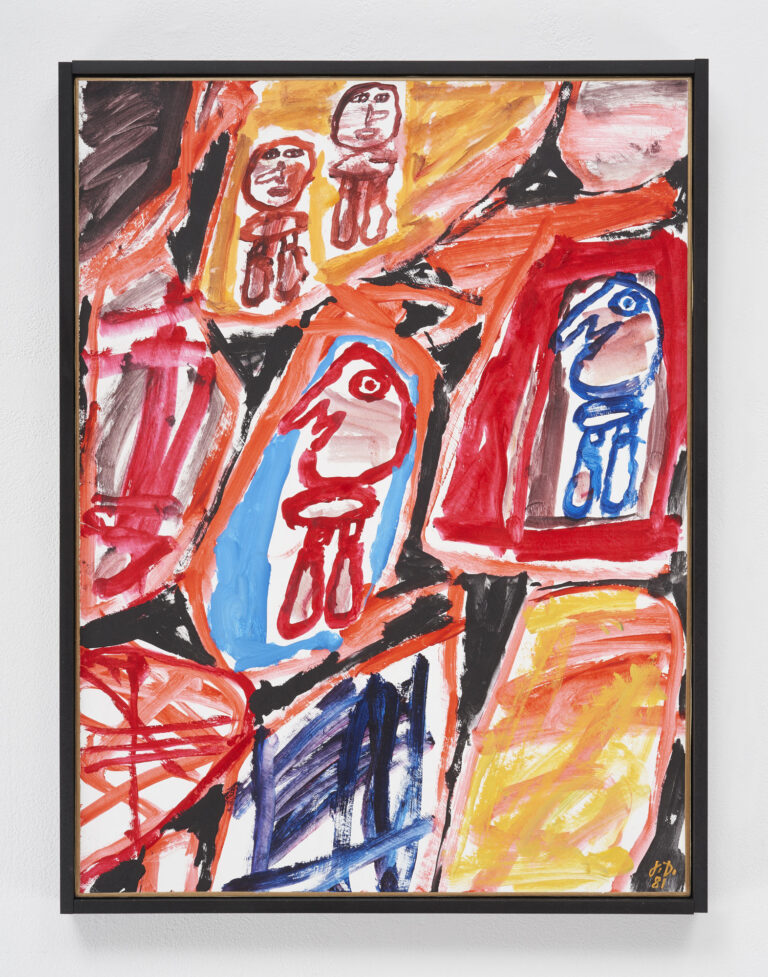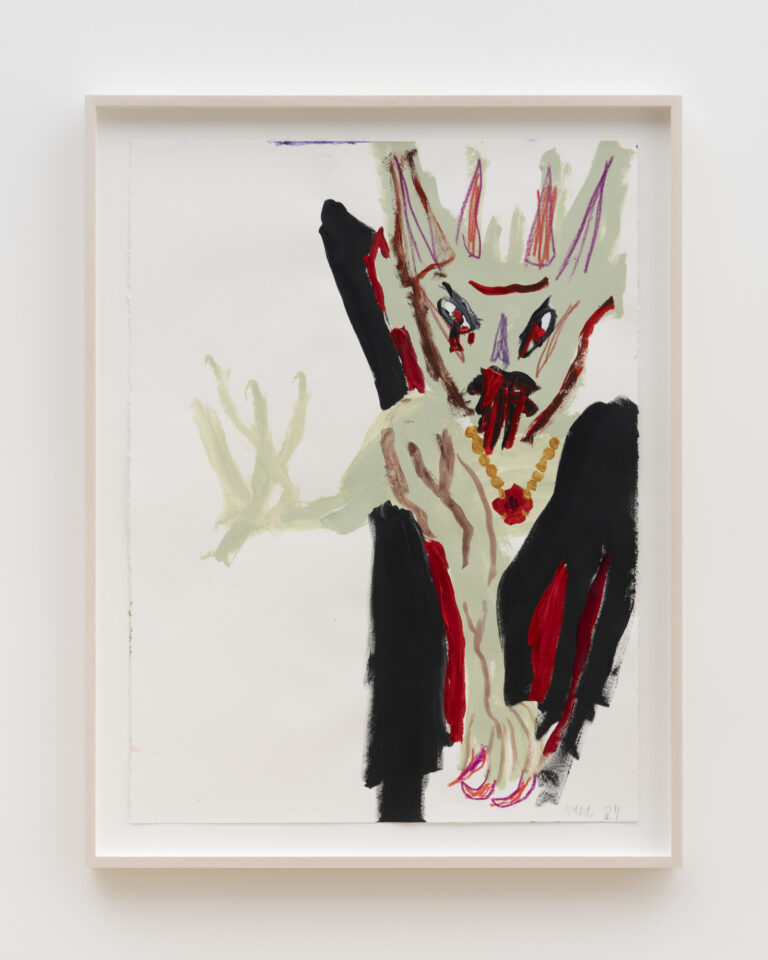Pace is pleased to announce the inaugural exhibition at its new space in Berlin’s Schöneberg neighborhood— marking a major milestone for the gallery’s presence in Europe. Reverse Alchemy: Dubuffet, Basquiat, Nava brings together works on paper by three artists of different generations who have transgressed and disrupted the language of figuration: Jean Dubuffet, Jean-Michel Basquiat, and Robert Nava. Anchored in Dubuffet’s “anti-cultural” celebration of art brut, this exhibition focuses on the medium of paper to explore how these artists perform a reverse alchemy, transmuting the gilded surfaces of “high art” back into its base elements— the raw, crude, and unhewn matter of mark-making—dismantling and exploding the figure in the act of rendering it. On view from May 2 through June 14, the exhibition inaugurates Pace’s new chapter in Berlin by reflecting on the outsized and profoundly disruptive influence of Dubuffet on both the history of art and the shape of contemporary practice.

Untitled, 1986
colored pencil, graphite, and acrylic on paper
29-1/2″ × 42″ (74.9 cm × 106.7 cm)
No. 94798
© Jean-Michel Basquiat,
Courtesy Pace Gallery
Coinciding with Gallery Weekend Berlin, Reverse Alchemy is one of two inaugural exhibitions at Die Tankstelle, a new art space—with galleries, offices, and an adjacent cafe and bookshop—housed in a converted 1950s gas station and shared by Pace and Galerie Judin. In a concurrent, complementary presentation, Galerie Judin will present an exhibition dedicated to Tom of Finland, an artist whose practice similarly challenged the distinctions between high and low art.
Pace’s exhibition juxtaposes a suite of late works on paper by Dubuffet dating from the late 1970s and 1980s with drawings that the young Basquiat—59 years Dubuffet’s junior—made during precisely the same time. Dubuffet’s and Basquiat’s works from the 1980s provide a context for recent works on paper by contemporary artist Robert Nava. Nava’s sensibility extends a legacy of expressive mark-making coupled with the rejection of traditional hierarchies in art, reflecting the continued influence of both Dubuffet and Basquiat on contemporary practice. Curated by Pace’s Chief Curator, Oliver Shultz, the exhibition follows the gallery’s solo presentations of Dubuffet—whom Pace has represented since 1967—and Nava this spring in New York. It also builds upon Dubuffet and Basquiat, a 2006 exhibition organized by Pace Founder and Chairman Arne Glimcher at Pace New York, which explored Dubuffet’s direct influence on Basquiat’s aesthetic.
Reverse Alchemy is presented on the occasion of Pace’s 65th anniversary year, during which the gallery is mounting exhibitions of work by major 20th century artists—with whom it has maintained decades-long relationships—at its spaces around the world.
The gallery’s upcoming exhibition in Berlin will examine how Dubuffet, Basquiat, and Nava have each redefined mark-making, figuration, and beauty itself. Centered around Dubuffet’s concept of art brut—a celebration of raw, instinctual creativity beyond academic traditions—the works on view revel in an expressive immediacy that collapses divisions between abstraction and figuration. Dubuffet’s textural, graffiti-like gestures reject refinement in favor of spontaneity and irreverence, a sensibility echoed in Basquiat’s frenetic compositions and Nava’s mythic, gestural landscapes. An uninhibited exuberance cuts through the work of all three artists, suggesting a contemporary mode of anti-figuration that distorts, abstracts, and dissolves the image even as it summons it into being.
Several of the Dubuffet works on view are drawn from the Théåtres de mémoire series (1975—78), in which the artist reconstructed fragments of his earlier paintings into layered, collage-like compositions that function as psychological landscapes. This recursive process—mining past visual vocabularies to generate new meaning— would later resonate with Basquiat. Although the two artists never met, Basquiat was profoundly influenced by Dubuffet’s work. By the mid-1980s, Basquiat had become an avid admirer, often asking Glimcher if he could sit in the gallery to observe installations of Dubuffet’s work.
Nava, whose tempestuous, chimerical figurations constitute a world of their own, extends the conversation opened by Dubuffet and Basquiat. If Dubuffet’s work has often been described as alchemical, Nava’s disfigurations and re-figurations of mythical beasts, imaginary monsters, and strange hybrids suggest a similar sense of mysterious transformation. His rejection of tradition and convention in favor of a free and deeply imaginative mode of making aligns with what curator Marcia Tucker examined in her 1978 New Museum exhibition Bad Painting. Tucker described “bad painting” as figurative work that “defies, either deliberately or by virtue of disinterest, the classic canons of good taste.” This concept was first articulated by Dubuffet in his lecture “Anticultural Positions,” delivered at the Art Institute of Chicago—in the city where Nava was born—in 1951. There, Dubuffet rejected the Western “notion of beauty as completely false… stifling and revolting.” Now, decades after Dubuffet and Basquiat transformed the medium of painting, Nava reignites the same disruptive energy with works that unsettle fixed ideas of beauty and taste, proposing a new kind of rebellion within the history of art.

Jean Dubuffet
Site avec 4 personnages, July 29, 1981
acrylic on canvas-backed paper
26-1/2″ x 19-3/4″ (67.3 x 50.2 cm)
No. 18041
© Jean Dubuffet / Artists
Rights Society (ARS), New York

Robert Nava
Vampire, 2024
acrylic, crayon, and grease pencil on paper
30″ × 22″ (76.2 cm × 55.9 cm)
No. 94376
© Robert Nava, courtesy
Pace Gallery
Pace—which maintains nine locations worldwide—established an office in Berlin in 2023, helmed by Senior Director Laura Attanasio, to focus on supporting institutional projects for its artists and deepening connections with collectors and arts communities in German-speaking regions. With the opening of Die Tankstelle, where Pace will mount two public exhibitions per year, the gallery reinforces its commitment to the European market. This collaboration also builds on a longstanding relationship between Pace and Galerie Judin, both of which represent Romanian artist Adrian Ghenie.
Throughout 2025, Pace is celebrating its 65th anniversary year with 16 exhibitions of work by artists who have been central to its program for decades. Presented around the world, these exhibitions are odes to some of the gallery’s longest-lasting relationships. Over the course of their careers, these figures, with Pace’s support, charted new courses in the history of art. Pace’s 65th anniversary presentations are listed chronologically below:
Joel Shapiro — Tokyo, January
Louise Nevelson — New York, January; Seoul, April
Kenneth Noland — Seoul, January; Tokyo, March
Sam Gilliam — Seoul, January; Tokyo, March
Jean Dubuffet — New York, March; Berlin, May
Robert Indiana — Hong Kong, March; New York, May
Robert Irwin — Los Angeles, April
Robert Mangold — New York, May
James Turrell — Seoul, June
Claes Oldenburg — Tokyo, July
Agnes Martin — New York, November
Pace is a leading international art gallery representing some of the most influential artists and estates of the
20th and 21st centuries, founded by Arne Glimcher in 1960. Holding decades-long relationships with Alexander Calder, Jean Dubuffet, Agnes Martin, Louise Nevelson, and Mark Rothko, Pace has a unique history that can be traced to its early support of artists central to the Abstract Expressionist and Light and Space movements. Now in its seventh decade, the gallery continues to nurture its longstanding relationships with its legacy artists and estates while also making an investment in the careers of contemporary artists, including Torkwase Dyson, Loie Hollowell, Robert Nava, Adam Pendleton, and Marina Perez Simäo.
Under the current leadership of CEO Marc Glimcher and President Samanthe Rubell, Pace has established itself as a collaborative force in the art world, partnering with other galleries and nonprofit organizations around the world in recent years. The gallery advances its mission to support its artists and share their visionary work with audiences and collectors around the world through a robust global program anchored by its exhibitions of both 20th century and contemporary art and scholarly projects from its imprint Pace
Publishing, which produces books introducing new voices to the art historical canon. This artist-first ethos also extends to public installations, philanthropic events, performances, and other interdisciplinary programming presented by Pace.
Today, Pace has nine locations worldwide, including two galleries in New York—its eight-story headquarters at 540 West 25th Street and an adjacent 8,000-square-foot exhibition space at 510 West 25th Street. The gallery’s history in the New York art world dates to 1963, when it opened its first space in the city on East 57th Street. A champion of Light and Space artists, Pace has also been active in California for some 60 years, opening its West Coast flagship in Los Angeles in 2022. The gallery maintains European footholds in London and Geneva as well as Berlin, where it established an office in 2023 and a gallery space in 2025. Pace was one of the first international galleries to have a major presence in Asia, where it has been active since 2008, the year it first opened in Beijing’s vibrant 798 Art District. It now operates galleries in Hong Kong and Seoul and opened its first gallery in Japan in Tokyo’s Azabudai Hills development in 2024.
